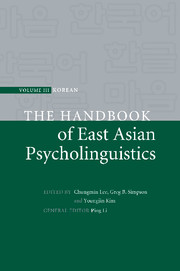Book contents
- Frontmatter
- Contents
- List of figures
- List of tables
- List of contributors
- Preface
- Introduction: Advances in Korean psycholinguistics
- Part I Language acquisition
- Part II Language processing
- 28 Visual processing of Hangul, the Korean script
- 29 English vowel spaces produced and perceived by Americans and Koreans
- 30 Morphological representation and processing of Sino-Korean words
- 31 The role of phonology in word recognition of Korean Hangul and Hanja
- 32 Lexical and sublexical processes in Korean word recognition
- 33 Prosody in sentence processing
- 34 Korean sentence processing
- 35 Sentence processing and memory representation in Korean
- 36 Understanding complex sentences: memory constraints and informational structure
- 37 ERP studies of Korean language processing: word-order effects
- 38 Inferences during discourse comprehension in Korean
- 39 Morpho-syntactic processing in Korean aphasics
- 40 Morpho-syntactic processing of Korean-speaking adults with Broca's aphasia
- 41 Comprehension deficits in Korean agrammatic aphasia
- 42 Developmental reading disorders in Korean
- 43 Individual differences in Korean language processing: context-dependent processing of skilled readers in word ambiguity resolution
- 44 A computational model of lexical and morphological processing in Korean
- References
- Name index
- Subject index
37 - ERP studies of Korean language processing: word-order effects
from Part II - Language processing
Published online by Cambridge University Press: 05 June 2012
- Frontmatter
- Contents
- List of figures
- List of tables
- List of contributors
- Preface
- Introduction: Advances in Korean psycholinguistics
- Part I Language acquisition
- Part II Language processing
- 28 Visual processing of Hangul, the Korean script
- 29 English vowel spaces produced and perceived by Americans and Koreans
- 30 Morphological representation and processing of Sino-Korean words
- 31 The role of phonology in word recognition of Korean Hangul and Hanja
- 32 Lexical and sublexical processes in Korean word recognition
- 33 Prosody in sentence processing
- 34 Korean sentence processing
- 35 Sentence processing and memory representation in Korean
- 36 Understanding complex sentences: memory constraints and informational structure
- 37 ERP studies of Korean language processing: word-order effects
- 38 Inferences during discourse comprehension in Korean
- 39 Morpho-syntactic processing in Korean aphasics
- 40 Morpho-syntactic processing of Korean-speaking adults with Broca's aphasia
- 41 Comprehension deficits in Korean agrammatic aphasia
- 42 Developmental reading disorders in Korean
- 43 Individual differences in Korean language processing: context-dependent processing of skilled readers in word ambiguity resolution
- 44 A computational model of lexical and morphological processing in Korean
- References
- Name index
- Subject index
Summary
Abstract
We investigated Korean language processing based on event-related potentials (ERPs) under congruent and incongruent conditions with semantic, syntactic, and combined errors. Fifteen participants were presented with visual stimuli consisting of 180 sentences ending in expected words (the congruent condition), 60 under the semantic condition, 60 under the syntactic condition, and 60 under the combined condition. The semantically incongruent condition was shown to elicit an N400 response, distributed in the right frontocentral region, as in semantic studies administered with Indo-European (IE) languages. The syntactically incongruent condition elicited P600 followed by N400 components but no early left-anterior negativity (ELAN) was detected, reflecting structural differences in Korean and IE languages. The doubly incongruent combined condition evoked N400 and P600 components with faster latency and higher amplitude compared to the syntactic conditions. The differences suggest that syntactic integration is influenced by semantic processing, but also that the semantic structure is independent of the syntactic context in the absence of semantic anomalies.
Introduction
Event-related brain potentials (ERPs) have been widely used to investigate the neurophysiological mechanisms of human language. ERP studies of language processes have indicated three main language-associated ERP components: the N400, early left-anterior negativity (ELAN) /left-anterior negativity (LAN), and P600 components (Hagoort et al., 1993; Kutas & Hillyard, 1980; Osterhout, 1994).
Kutas and Hillyard (1980) presented visual sentence stimuli with unexpected or incongruent endings and found a negative peak around 400 ms, observing that N400 is an “electrophysiological marker of the ‘reprocessing’ of semantically incongruent information.
- Type
- Chapter
- Information
- The Handbook of East Asian Psycholinguistics , pp. 463 - 473Publisher: Cambridge University PressPrint publication year: 2009

